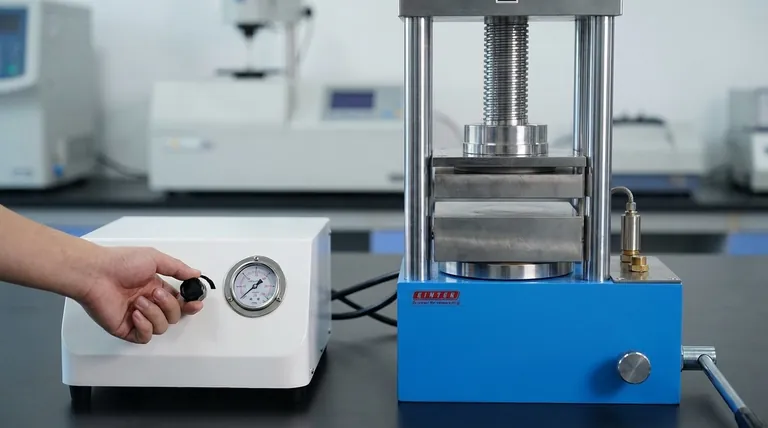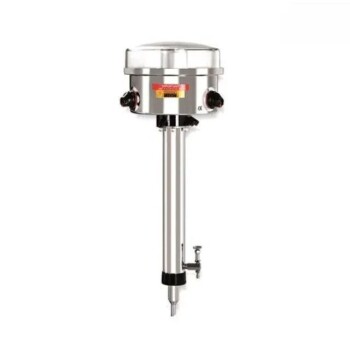In any hydraulic system, you can increase the output force in two fundamental ways: increase the system's fluid pressure or increase the surface area of the actuator (like the piston in a cylinder) that the pressure acts upon. Both methods are a direct application of the core principles of fluid power.
The central challenge isn't just about increasing force, but about understanding the consequences. Every change you make to increase force will have a direct trade-off with system speed, component safety, or overall cost.

Understanding the Foundation: Pascal's Law
Before adjusting any component, it is critical to understand the principle that governs every hydraulic system.
The Core Formula: Force = Pressure x Area
Pascal's Law states that pressure exerted on a confined fluid is transmitted undiminished throughout the fluid. This is captured in the simple but powerful formula: Force = Pressure × Area.
This formula tells you everything you need to know. To get more force, you must either increase the pressure value or the area value. There are no other variables to change.
How Pressure and Area Work Together
Think of pressure as the level of effort the fluid is exerting, measured in pounds per square inch (psi) or bar. The area is the size of the surface, like a piston head, that this effort pushes against.
A small amount of pressure acting on a very large area can produce an enormous force. This force multiplication is the primary reason we use hydraulics.
Two Primary Methods to Increase Output Force
With the core formula in mind, we can look at the two practical levers you can pull to change the force output.
Method 1: Increase System Pressure
The most direct way to get more force is to increase the system's operating pressure. In most systems, this is controlled by a pressure relief valve.
The pump creates fluid flow, but pressure is created by resistance to that flow (i.e., the load you're trying to move). The pressure relief valve acts as a ceiling, diverting excess flow back to the tank once a set pressure is reached.
By carefully adjusting this valve, you can raise the maximum pressure the system is allowed to build, which directly increases the output force for a given actuator size.
Method 2: Increase Actuator Surface Area
The second method is to change the physical components. If you replace a hydraulic cylinder with one that has a larger bore (a wider piston diameter), you increase the surface area.
According to our formula (F = P x A), if the pressure stays the same but the area increases, the output force must also increase proportionally. This is often a consideration during the design phase of a system.
Understanding the Inherent Trade-offs
Increasing force is never free. It is critical to understand the consequences of each method to ensure you make a safe and effective decision.
Pressure vs. Component Safety
Increasing pressure puts more strain on every single component in the system. Hoses, fittings, seals, valves, the pump, and the actuator itself must all be rated to handle the new, higher pressure.
Exceeding a component's pressure rating is the single fastest way to cause a catastrophic, and often dangerous, system failure. Always verify the pressure rating of the weakest component before making adjustments.
Force vs. Speed
There is a direct trade-off between force and speed. When you increase force by using a larger-bore cylinder (more area), that cylinder requires more fluid volume to extend the same distance.
If your pump's flow rate remains constant, the larger cylinder will move slower. To get both higher force and the same speed, you would need a larger pump capable of a higher flow rate, which requires more horsepower.
Cost vs. Capability
Both methods for increasing force come with cost implications. Higher-pressure components are more expensive because they must be built to stricter tolerances with stronger materials. Larger cylinders are more expensive due to the increased material and manufacturing costs.
Making the Right Choice for Your Goal
Your strategy should be dictated by your specific needs and the constraints of your existing system.
- If your focus is a minor force increase on an existing system: Carefully adjust the pressure relief valve, ensuring you stay well within the maximum pressure rating of all system components.
- If your focus is a significant force increase or designing a new system: Selecting a larger-bore cylinder is often the safer, more robust long-term solution.
- If your focus is increasing force while maintaining or increasing speed: You must plan for a system-level upgrade, which typically involves both a larger cylinder and a higher-flow-rate pump.
Ultimately, mastering hydraulic force comes from balancing your desired output with the physical and financial limitations of your system.
Summary Table:
| Method | How It Works | Key Consideration |
|---|---|---|
| Increase System Pressure | Adjust the pressure relief valve to allow higher PSI. | All components must be rated for the new, higher pressure to avoid failure. |
| Increase Actuator Area | Use a cylinder with a larger bore diameter. | A larger cylinder will move slower unless pump flow rate is also increased. |
Need to optimize your hydraulic system for greater force and reliability? The experts at KINTEK are here to help. We specialize in providing robust lab equipment and consumables, including hydraulic components designed for precise performance and safety. Whether you're designing a new system or upgrading an existing one, we can help you select the right components to achieve your power goals without compromising on speed or safety.
Contact our engineering team today for a personalized consultation and see how KINTEK can power your laboratory's success.
Visual Guide

Related Products
- Manual Lab Heat Press
- Manual Heated Hydraulic Press Machine with Heated Plates for Laboratory Hot Press
- Manual High Temperature Heated Hydraulic Press Machine with Heated Plates for Lab
- Automatic High Temperature Heated Hydraulic Press Machine with Heated Plates for Lab
- Laboratory Manual Hydraulic Pellet Press for Lab Use
People Also Ask
- How much force can a hydraulic press exert? Understanding its immense power and design limits.
- What are the failures of a hydraulic press? Prevent Downtime and Ensure Safety in Your Lab
- What are the parts of a manual hydraulic press? A Guide to Its Core Components and Operation
- What is the conclusion of a hydraulic press? Unmatched Force for Industrial Applications
- What are the potential hazards in a hydraulic press? Understanding the Risks of Crushing, Injection, and Failure
















